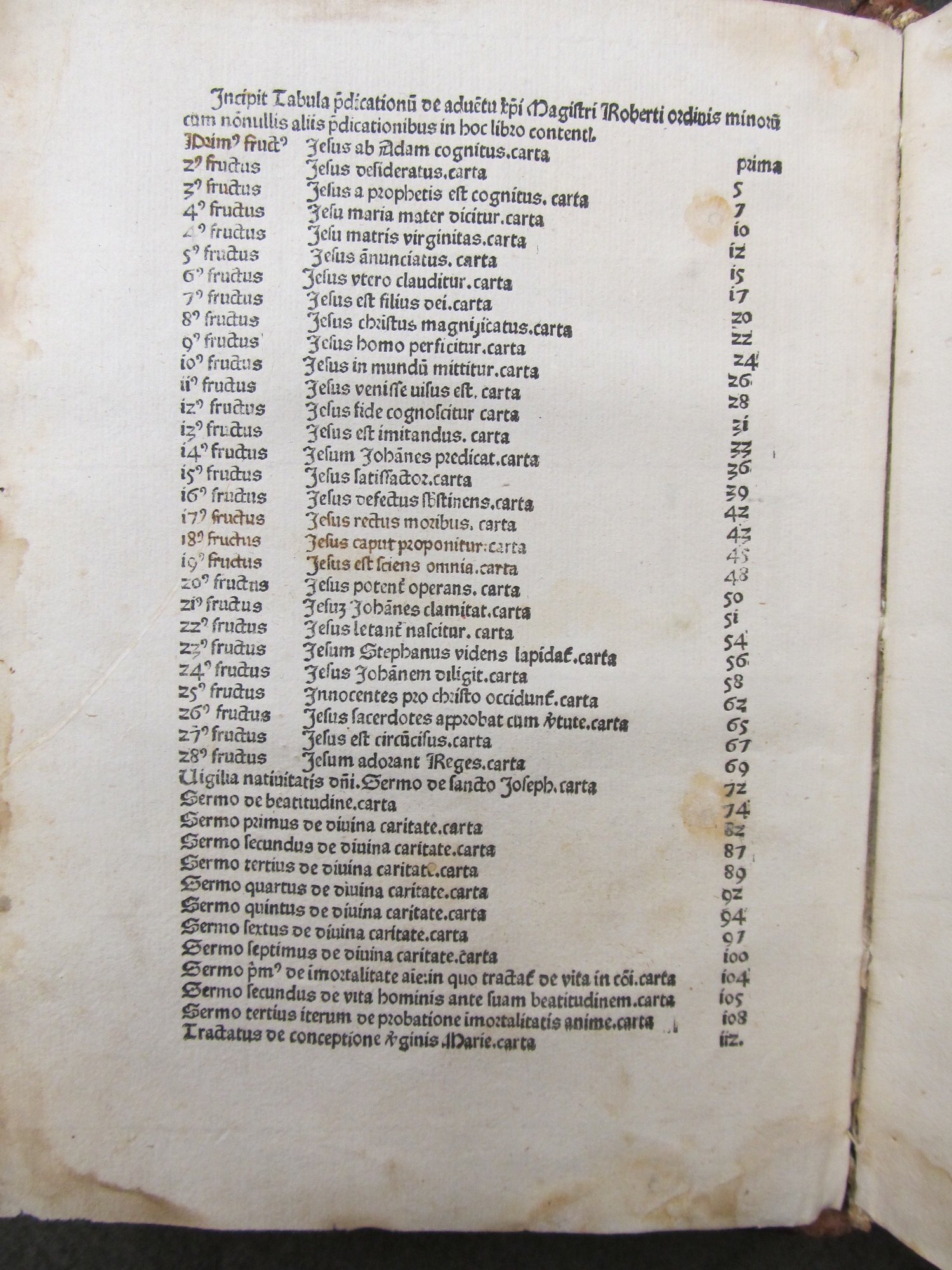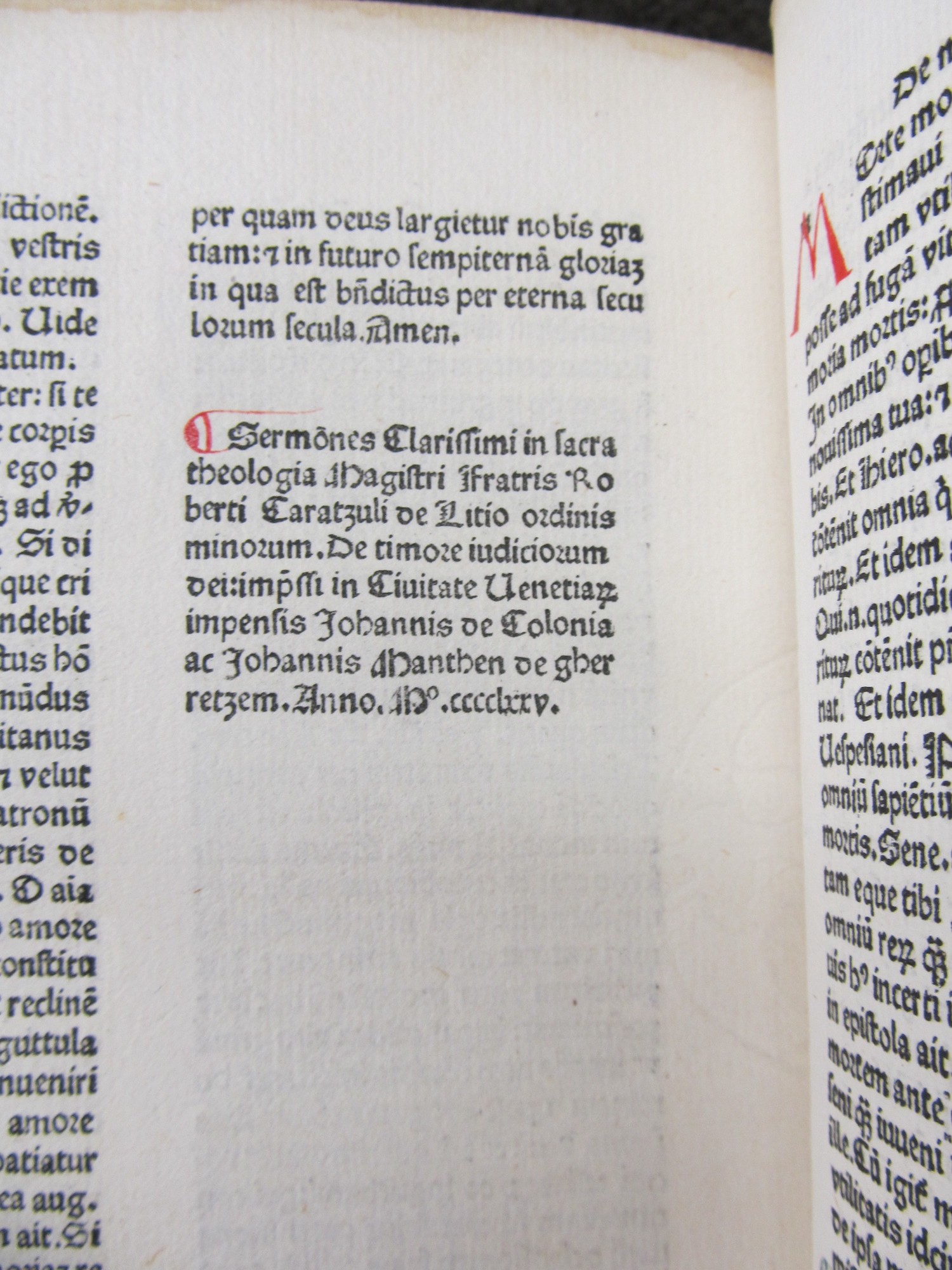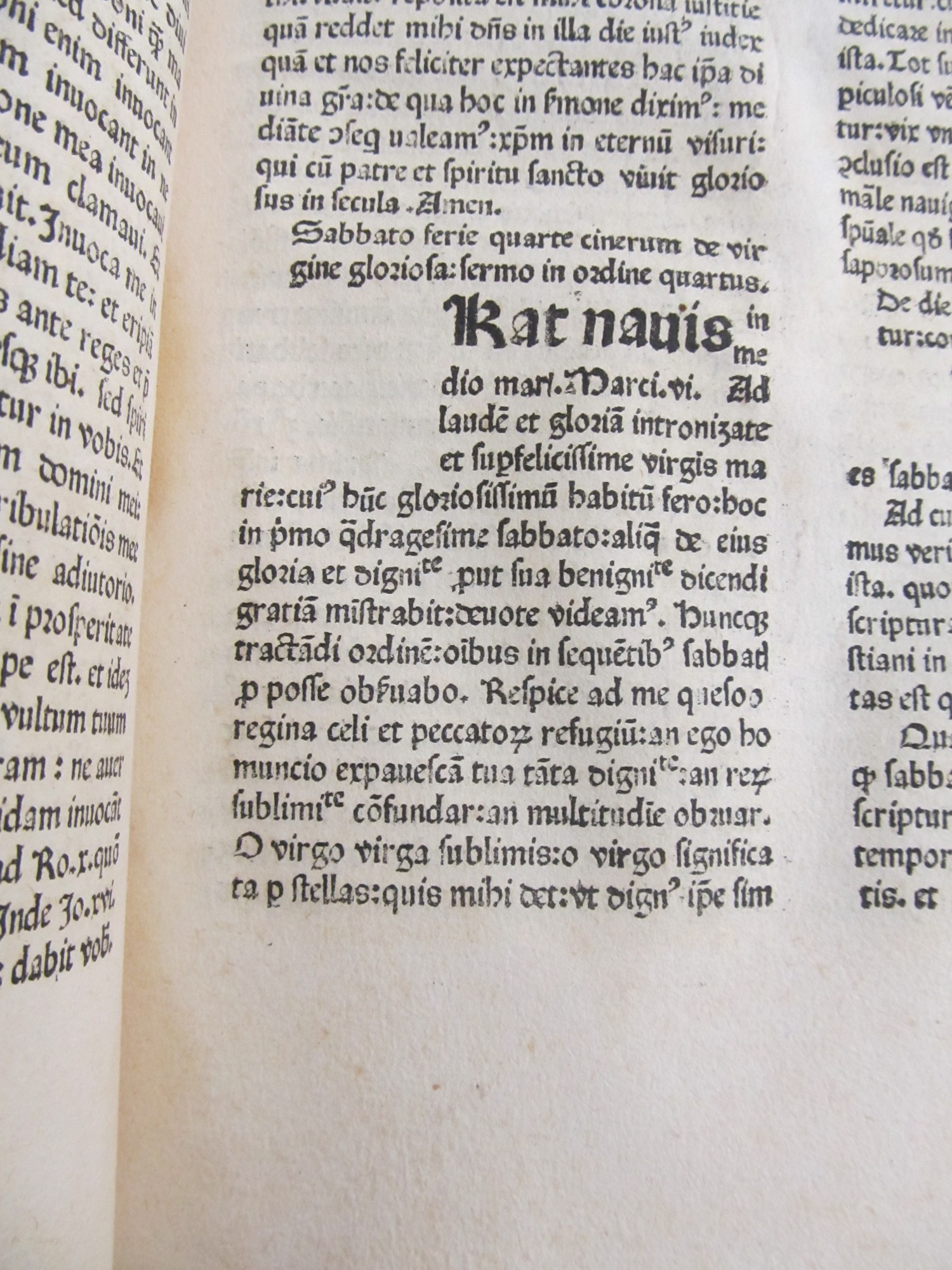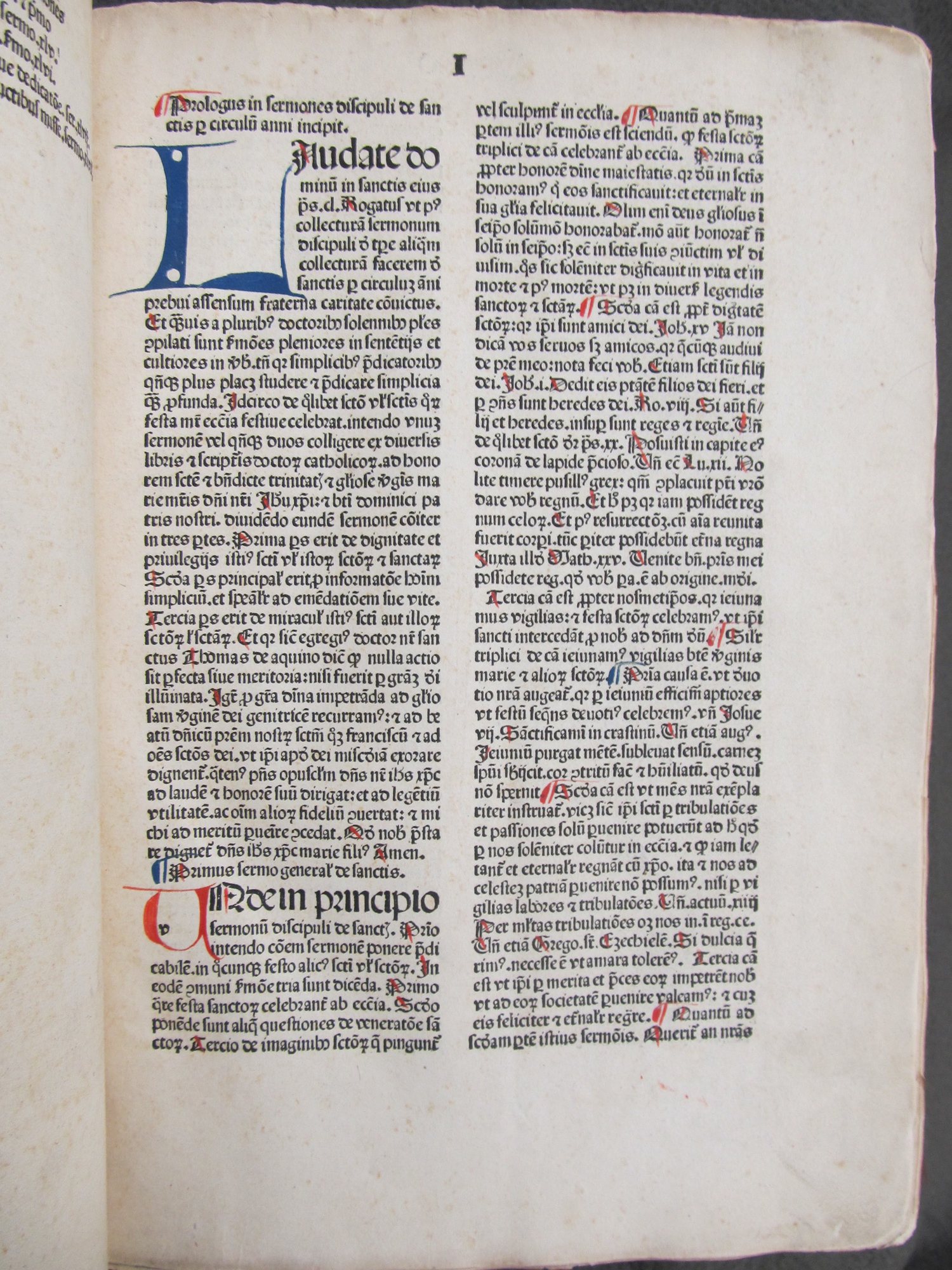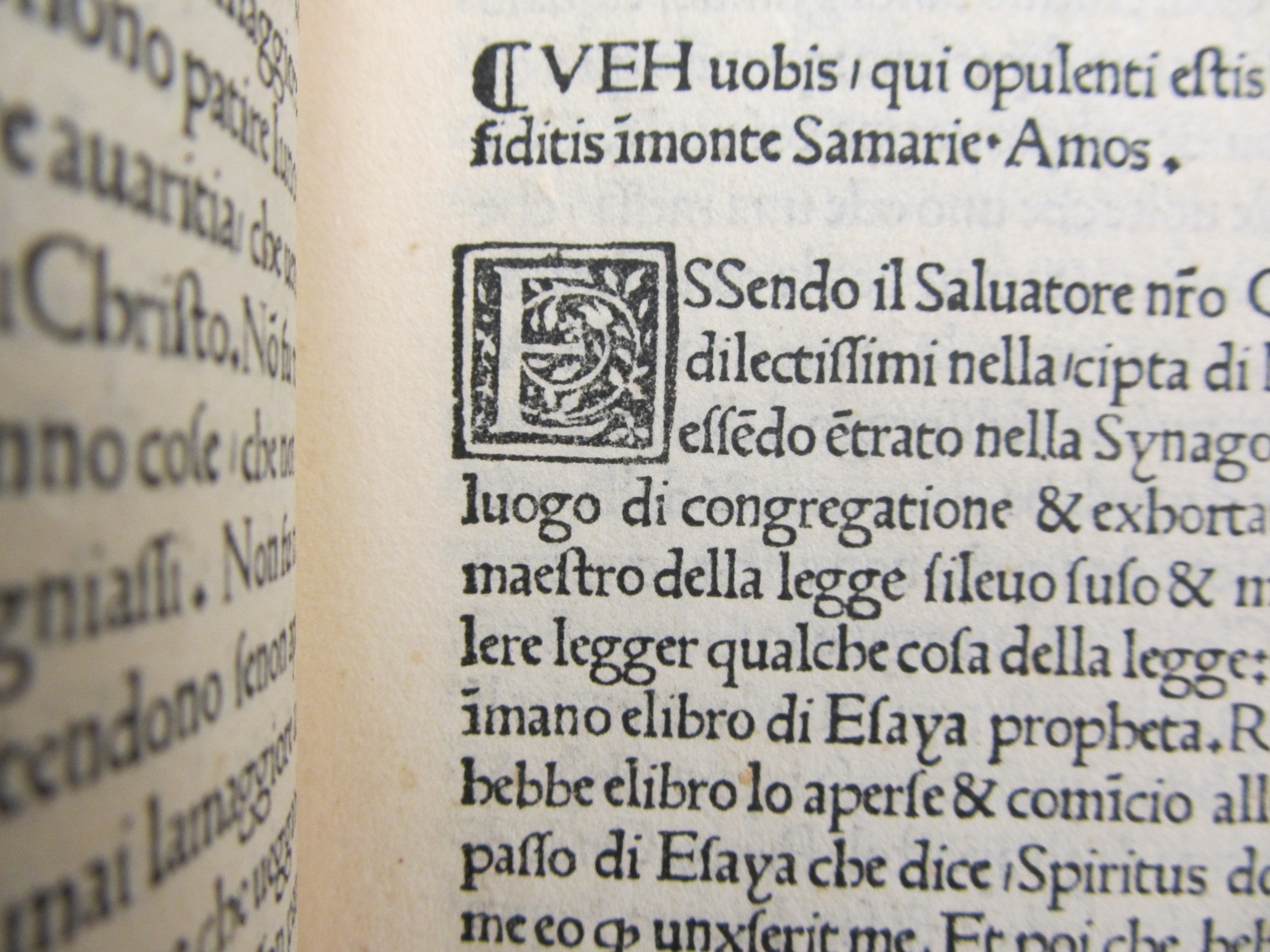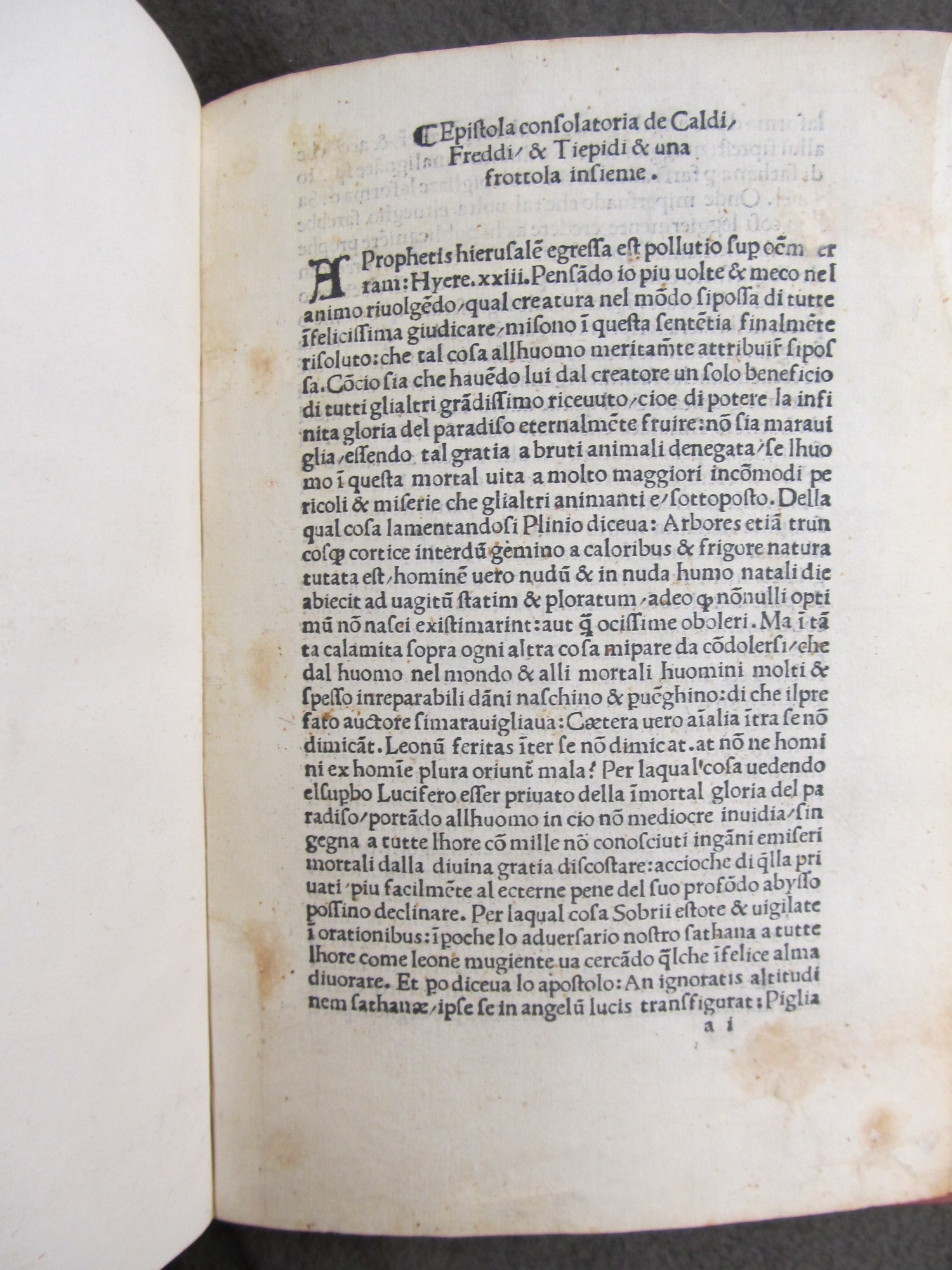Incunables in Special Collections
Printed Sermons
Strange though it may seem today, sermons were once one of the most commonly printed materials. Even during the manuscript period before the advent of the printing press, sermons were being published on a wide scale. They were read by Christians engaged in lay piety, served as models for preachers writing their own sermons, and clarified theological points for university students, to name only three possible purposes. During the incunable period, sermons that had once circulated in manuscript could now finally be bought in larger numbers.
Special Collections' incunable sermons are mainly drawn from Italy and (with one possible exception) were written by members of three mendicant orders: the Dominicans, the Franciscans, and the Servites. These orders, particularly the Dominicans and Franciscans, were hugely influential in medieval Europe. Their itinerent preaching had resulted in the mass production of small, standardized, portable Bibles during the 13th century and with the books on display here, they were contributing to the reception of the Bible through their ministry.
The sermon as a genre has contracted since its heyday as some of its social and intellectual functions taken up by other genres. Can you think of other genres whose boundaries have shifted over time?
Sermones de adventu, etc.
Caracciolo, Roberto, 1425-1495.
Venice: Johann of Cologne and Johann Manthen, ca. 1474
BX1756.C315 S46 1474
De timore iudicorum Dei
Caracciolo, Roberto, 1425-1495.
Venice: Johann of Cologne and Johann Manthen, 1475
BX1756.C315 S46 1474
Roberto Caracciolo of Lecce was a Franciscan friar and among the most famous Italian preachers of his time, known for the melodrama and spectacle of his sermons. In 1475, just after this edition of his sermons was published, he would become bishop of Aquino. In total 80 incunable editions of his writings were published, cementing his reputation as an important sermon writer.
The book of Caracciolo's writings held by Special Collections is a Sammelband, combining Sermones de adventu and the works printed alongside it with another collection of Caracciolo's sermons, De timore iudiciorum Dei. The binding has incorporated part of a Latin manuscript on parchment, a common binding practice in the Middle Ages. The rubrication has the quirk that some of the capital letter N's were done backwards.
Quadragesimale de floribus sapientie
Spiera, Ambrosius de, d. 1454
Venice: Wendelin of Speyer, 1476
BV4277.S65 Q3 1476
Antonio de Spiera was the son of a teacher at a public gymnasium in Treviso, taking the name "Ambrosius" when he joined the Servite Friars. The Quadragesimale is a group of sermons delivered during the season of Lent. The sermons were not meant for a general audience, however, but were directed towards theology students and therefore are aimed at discussing theology in simple (albeit heavily researched) terms. Ambrosius excelled at clearly and concisely presenting multiple theological perspectives and offering a dispassionate analysis. The book would eventually go through at least eight editions after this one, which was the first.
Special Collections' copy of this book has an ownership inscription indicating that it belonged to Cardinal Giuliano Cesarini the Younger. Cesarini was cardinal from 1493 until 1510 and participated in the 1503 conclaves that would elect Pius III (who was only pope for 26 days before dying of the gout) and Julius II. Julius II, also called "the Warrior Pope" because of his active military campaigning while in office, expelled the Borgias from power in Italy and commissioned the ceiling painting of Sistine Chapel.
Wendelin of Speyer was a German-born printer operating in Venice, initially in collaboration with his brother Johann. After Johann died in 1470, Wendelin published the first Italian-language Bible in 1471, and would go on to collaborate with Johann of Cologne, who helped publish the collection of Caracciolo's sermons in Special Collections (see above).
Sermones Discipuli de tempore et de sanctis etc.
Herolt, Johann, d. 1468.
Strasbourg: printer of the 1483 Vitas patrum, 1484
BX1756.H4485 S47 1484
Johann Herolt was a Dominican prior and lector in Nuremberg. In his capacity as lector, Herolt was responsible for supporting the intellectual life of his community, which he may have done through sermon-writing. He was revered for his sermon books, which he wrote under the name "Discipulus," meaning "the Student." Herolt's work circulated widely in both manuscript and print. There are 63 different incunable editions of works attributed to Discipulus and this book represents a set of sermons that were frequently printed together: Sermones de tempore, Sermones de sanctis, Promptarium exemplorum discipul secundum ordinem alphabeti, and Promptuarium de miraculis Beate Marie Virginis.
Special Collections' copy of this book has an ownership mark indicating that it once belonged to someone affiliated with a religious order near the northern French town of Clairmarais. This person appears to have practiced writing something on the back page. The book displays multi-color rubrication as well as some excellent watermarks. Sadly, several pages from the beginning of the first sermon are missing.
Prediche di Frate Hieronymo da Ferrara
Savonarola, Girolamo, 1452-1498
Florence?: Lorenzo Viuuoli Lano, 1496
BX1756.S347 P7 1496
Girolamo Savonarola was a Dominican friar, preacher, and political activist in 15th-century Florence. When the French invaded Italy in 1494 and the Medicis were expelled from Florence, Savonarola urged the Florentines to establish a republic. He resisted Pope Alexander's attempts to bring him to heel and was even excommunicated in 1497, which was the beginning of the end for him. He was compelled to submit to the first trial by fire in Florence for over 400 years in 1498. He was eventually condemned to death in 1498 and was hanged; his corpse was burned to prevent his followers from taking relics. This book is a collection of Savonarola's sermons, likely published at the zenith of his influence.
Special Collections' copy of this book has an exciting ownership inscription from the Florentine noblewoman Signora Laudomia Ricasoli Ridolfi on the first page. Signora Laudomine was the widow of the 17th-century Florentine nobleman Cosimo Ridolfi, who styled himself as a "rustic magus." Ridolfi had been part of the entourage of Don Giovanni, a bastard son of Cosimo I, who collected rare books, especially those banned by the Florentine Inquisition. Signora Laudomine was not a fan of her husband's occult friends and would eventually sell his books after his death, but evidently liked this book enough to put her name in it.
Epistola consolatoria de Caldi, Freddi, & Tiepidi & una frottola insieme
Sebastianus P.
Florence: Lorenzo Morgiani and Johann Petri, ca. 1496
DG737.97 .P2
It is not uncommon for early printed books' authors to be unknown: this particular book's author is identified only as "Sebastianus P." It was published by Lorenzo Morgiani and Johann Petri, a prolific pair of printers who printed more than 100 editions together and whose workshop was consequently one of the most important in 15th-century Florence. Morgiani printed many works written by Girolamo Savonarola, publishing 27 editions of Savonarola's works, particularly short sermons.
Special Collections' copy of this book is quite rare: only three other copies are known to exist. One is at the Pierpoint Morgan Library in New York, one belongs to the Peterborough Cathedral (currently on deposit at the Cambridge University Library), and one is at the Württembergische Landesbibliothek in Stuttgart. The fourth leaf of Special Collections' copy is missing and has been replaced with a facsimile based on the Pierpont Morgan Library's copy. Missing leaves like this one are a reminder of the book's great age: every complete or nearly complete codex is a treasure.
